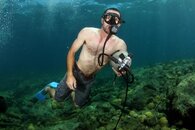Texasguy
Contributor
My buoyancy and trim are getting better. I want to try something (wanted to do it for a long time already):
I usually dive steel but I have one aluminum 80cu catalina tank. I was thinking of diving where it is shallow with just a tank in my hands, no BC. I bet it would be an ultimate test of buoyancy.
Many years ago before BCs came to be popular, people would strap a tank to their harness and jump in. Thus, I am asking those pioneers. What was a method of weighting yourself and a tank?
I was thinking, give a tank as much weight so it would be neutral when near empty. Give yourself enough weight where you sink without air but rise with a full breath.
Now to the part of actual diving. Without BC, I believe, it would be harder to maintain buoyancy. Are there any tips and tricks?
I usually dive steel but I have one aluminum 80cu catalina tank. I was thinking of diving where it is shallow with just a tank in my hands, no BC. I bet it would be an ultimate test of buoyancy.
Many years ago before BCs came to be popular, people would strap a tank to their harness and jump in. Thus, I am asking those pioneers. What was a method of weighting yourself and a tank?
I was thinking, give a tank as much weight so it would be neutral when near empty. Give yourself enough weight where you sink without air but rise with a full breath.
Now to the part of actual diving. Without BC, I believe, it would be harder to maintain buoyancy. Are there any tips and tricks?





